
Unlocking the Secrets of Our Ancestors: New Discoveries from 2-Million-Year-Old Tooth Enamel
2025-07-12
Author: John Tan
A Breakthrough in Understanding Our Ancestors
For decades, scientists have been captivated by the enigmatic fossils of Paranthropus robustus, a robust relative of early humans that thrived between 2.25 and 1.7 million years ago. Standing upright with formidable jaws and massive teeth, this ancient species is now shedding light on our evolutionary past.
A Rich Family Tree of Hominins
The South African fossil record is rich with hominin relatives of modern humans, featuring a range of species from Australopithecus to early members of Homo. These fossils chronicle key milestones in evolution, such as bipedalism, tool-making, and cognitive development, ultimately leading to the emergence of Homo sapiens around 153,000 years ago.
From Questions to Discoveries
Despite the importance of P. robustus, significant questions remained unanswered: How much variability existed within this species? Were size differences linked to sex or multiple species? How closely were they related to other hominins and what made them genetically unique?
Past attempts to decode these mysteries have relied heavily on ancient DNA, which often degrades in warmer climates such as Africa. However, a pioneering team of researchers turned to paleoproteomics—the analysis of ancient proteins—providing a fresh approach to uncover these secrets.
Unraveling Genetic Mysteries
In a groundbreaking move, researchers extracted proteins from the enamel of four P. robustus teeth, preserving them remarkably well due to their attachment to teeth and bones. Astonishingly, they discovered biological sex indicators revealing two males and two females among the fossils.
Are There Multiple Species?
The analysis uncovered genetic differences, particularly within a gene responsible for producing enamelin—a crucial enamel-forming protein. Two individuals shared genetic traits with modern humans and great apes, while the other two exhibited unique characteristics linked specifically to Paranthropus.
Excitingly, one individual displayed signs of heterozygosity, marking the first instance of such genetic diversity documented in proteins from two million years ago. This finding suggests that rather than a single variant species, we might be looking at a more intricate web of evolutionary influences.
Future Directions and Preservation
To validate these findings, the research team plans to sample more P. robustus specimens from various locations in South Africa, ensuring that their methods maintain respect for fossil heritage while advancing scientific understanding.
A New Era in Paleontology
This research underscores the importance of conducting high-level science in Africa, enabling local researchers to lead these transformative studies. As paleoproteomics continues to evolve and more fossils are examined, we remain on the brink of unveiling deeper, more complex narratives about our ancient relatives.
The Paranthropus story is no longer just a puzzle; it’s an exciting journey into the depths of our ancestry, promising more discoveries that will reshape our understanding of human evolution.



 Brasil (PT)
Brasil (PT)
 Canada (EN)
Canada (EN)
 Chile (ES)
Chile (ES)
 Česko (CS)
Česko (CS)
 대한민국 (KO)
대한민국 (KO)
 España (ES)
España (ES)
 France (FR)
France (FR)
 Hong Kong (EN)
Hong Kong (EN)
 Italia (IT)
Italia (IT)
 日本 (JA)
日本 (JA)
 Magyarország (HU)
Magyarország (HU)
 Norge (NO)
Norge (NO)
 Polska (PL)
Polska (PL)
 Schweiz (DE)
Schweiz (DE)
 Singapore (EN)
Singapore (EN)
 Sverige (SV)
Sverige (SV)
 Suomi (FI)
Suomi (FI)
 Türkiye (TR)
Türkiye (TR)
 الإمارات العربية المتحدة (AR)
الإمارات العربية المتحدة (AR)